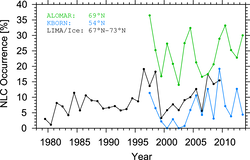NLC and trends
The highest clouds in the Earth atmosphere are located around 83 km altitude and are called noctilucent clouds (NLC). They occur during the summer months from mid to high latitudes and are a visible sign of the extreme conditions in the mesopause region. NLC consist of nano-sized ice particles. Ice formation and growth at these high altitudes is very sensitive to temperature and water vapor content which are hardly to measure directly with high accuracy. Thus NLC are important as tracers for long-term changes in the middle atmosphere.
The first NLC observations were documented in 1885. Since the beginning the clouds attracted the interest of a growing number of observers and it was realized that the bluish-white displays reoccurred every summer between evening and morning twilight. The longest time series of visual observations cover more than 40 years. Since 1979 NLC are also observed by satellite instruments on routine basis.
IAP investigates NLC by lidar measurements at Kühlungsborn (54°N) and ALOMAR (69°N) as well as model calculations (LIMA/Ice). The measurements of NLC occurence frequency, altitude and brightness cover about 20 years. These are the most extensive NLC data sets obtained by lidar so far.

The first NLC observations were documented in 1885. Since the beginning the clouds attracted the interest of a growing number of observers and it was realized that the bluish-white displays reoccurred every summer between evening and morning twilight. The longest time series of visual observations cover more than 40 years. Since 1979 NLC are also observed by satellite instruments on routine basis.
IAP investigates NLC by lidar measurements at Kühlungsborn (54°N) and ALOMAR (69°N) as well as model calculations (LIMA/Ice). The measurements of NLC occurence frequency, altitude and brightness cover about 20 years. These are the most extensive NLC data sets obtained by lidar so far.
Selected publications
- F.-J. Lübken, G. Baumgarten und U. Berger, Long term trends of mesopheric ice layers: A model study, J. Atmos. Solar-Terr. Phys., doi:10.1016/j.jastp.2020.105378, 2021.
- F.-J. Lübken, U. Berger und G. Baumgarten, On the anthropogenic impact on long-term evolution of noctilucent clouds, Geophys. Res. Lett., 45, 6681-6689, doi:10.1029/2018GL077719, 2018.
- J. Fiedler, G. Baumgarten, U. Berger und F.-J. Lübken, Long-term variations of noctilucent clouds at ALOMAR, J. Atmos. Solar-Terr. Phys., 162, 79-89, doi:10.1016/j.jastp.2016.08.006, 2017.
- U. Berger und F.-J. Lübken, Trends in mesospheric ice layers in the northern hemisphere during 1961 - 2013, J. Geophys. Res., 120, 11,277-11,298, doi:10.1002/2015JD023355, 2015.
- M. Gerding, J. Höffner, P. Hoffmann, M. Kopp und F.-J. Lübken, Noctilucent cloud variability and mean parameters from 15 years of lidar observations at a mid-latitude site (54°N, 12°E), J. Geophys. Res., doi:10.1029/2012JD018319, 2013.












